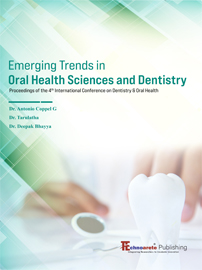


Post Graduate Student, Department of Pediatric and Preventive Dentistry, Chettinad Dental College & Research Institute, Chennai, India, 603103; shruthipedo07@gmail.com
Corresponding Author: shruthipedo07@gmail.com
Professor and Head, Department of Pediatric and preventive dentistry, Chettinad dental college and Research Institute, Chennai, India, postcode-603103;
Corresponding Author: ayaswathi@gmail.com;
Professor, Department of Pediatric and Preventive Dentistry, Chettinad Dental College and Research Institute, Chennai, India, 603103;
Corresponding Author: dr.eaga_ars@yahoo.com
Department of Pedodontics and Preventive Dentistry, Chettinad Dental College & Research Institute, Rajiv Gandhi Salai, Kelambakkam, Kancheepuram District, Tamil Nadu – 603 103, India
The study aimed to correlate the thumbprints and palatal rugae patterns with the behavior of the children. 120 children ranging from 5 to 12 years of age were included in the study. Behavior patterns, palatal rugae, and thumbprints of the participants were recorded during their first dental visit. Thumbprints and palatal rugae were recorded using Cummins classification and Thomaz & Kotze classification respectively. The Frankl-Behaviour Rating scale was used to examine children's behaviour. The data was tabulated and evaluated statistically using the chi-square test. It was observed that children with loop patterns of the thumbprints and wavy rugae patterns exhibited positive and definitely positive Frankl behavior. Statistically significant association was observed between thumbprints, palatal rugae patterns and children's behavior (p = 0.012; p = 0.033). Hence, both thumbprints and palatal rugae patterns could be utilized as a behavior marker during the first dental visit, which help clinicians provide superior treatment and improve their behaviour.
[1] Shinohara S, Nomura Y, Shingyouchi K, Takase A, Ide M, Moriyasu K, Idaira Y, Takahashi T, Yamada Y, Aoyagi Y, Asada Y. Structural relationship of child behavior and its evaluation during dental treatment. J Oral Sci. 2005;47(2):91-6
[2] McDonald RE, Avery DR, Dean AJ. In: Dentistry for the child and adolescent. 8th edition. St. Louis: Mosby. 2004:729.
[3] Sharma A, Tyagi R. Behavior assessment of children in dental settings: A retrospective study. Int. J Clin Pediatr. Dent. 2011;4(1):35.
[4] .Rastogi P, Pillai KR. A study of fingerprints in relation to gender and blood group. J. Indian Acad. Forensic Med. 2010;32(1):11-4.
[5] Kataria AP, Konidena A, Puri G, Patil DJ, Gupta R. Reliability of digitized cheiloscopy, dactyloscopy and combination approach for gender identification–A comparative study. J Indian Acad Oral Med Radiol. 2020;32(1):9.
[6] Bhateja S, Arora G. Analysis of palatal rugae for human identification in Indian (Mathura) population. Indian J Dent Sci. 2013; 5(3):24-7.
[7] Marwah N. Textbook of Pediatric dentistry. 3rd ed., New Delhi: Jaypee Brothers Medical Publishers Ltd. 2014:219–220.1
[8] Navit S, Pramanik S, Khan SA, et al. Cheiloscopy and Dactyloscopy as Behavior Assessment Tool in Dental Settings: A Cross-sectional Study. Int J Clin Pediatr Dent. 2021;14(2):238–242.
[9] Azhagiri R, Anitha M, Hemapriya J. Analysis of left thumb print pattern among different human blood groups. Int J Anat Var. 2018;11(3):103–106
[10]. Rajan VP, John JB, Stalin A, Priya G, Abuthagir AK. Morphology of palatal rugae patterns among 5‑15 years old children. J Pharm Bioallied Sci. 2013;5:S43.
[11]Agarwal M, Alex A, Konde S. Relationship between dermatoglyphics, cheiloscopy, rugoscopy, and dental caries: a cross-sectional study in Bengaluru, Karnataka. Contemp Clin Dent. 2018;9(4):577-81 .